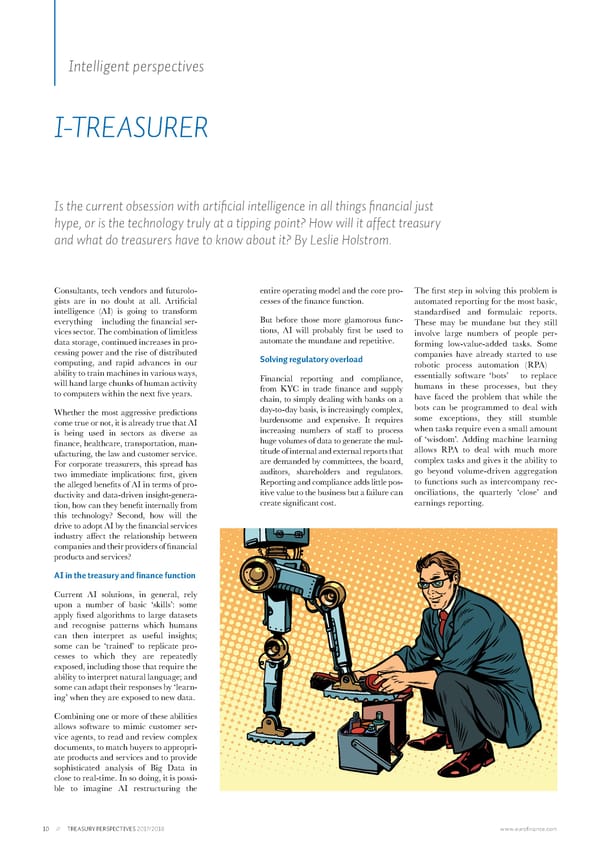Intelligent perspectives I-TREASURER Is the current obsession with artificial intelligence in all things financial just hype, or is the technology truly at a tipping point? How will it affect treasury and what do treasurers have to know about it? By Leslie Holstrom. Consultants, tech vendors and futurolo- entire operating model and the core pro- The first step in solving this problem is gists are in no doubt at all. Artificial cesses of the finance function. automated reporting for the most basic, intelligence (AI) is going to transform standardised and formulaic reports. everything – including the financial ser- But before those more glamorous func- These may be mundane but they still vices sector. The combination of limitless tions, AI will probably first be used to involve large numbers of people per- data storage, continued increases in pro- automate the mundane and repetitive. forming low-value-added tasks. Some cessing power and the rise of distributed Solving regulatory overload companies have already started to use computing, and rapid advances in our robotic process automation (RPA) – ability to train machines in various ways, Financial reporting and compliance, essentially software ‘bots’ – to replace will hand large chunks of human activity from KYC in trade finance and supply humans in these processes, but they to computers within the next five years. chain, to simply dealing with banks on a have faced the problem that while the Whether the most aggressive predictions day-to-day basis, is increasingly complex, bots can be programmed to deal with come true or not, it is already true that AI burdensome and expensive. It requires some exceptions, they still stumble is being used in sectors as diverse as increasing numbers of staff to process when tasks require even a small amount finance, healthcare, transportation, man- huge volumes of data to generate the mul- of ‘wisdom’. Adding machine learning ufacturing, the law and customer service. titude of internal and external reports that allows RPA to deal with much more For corporate treasurers, this spread has are demanded by committees, the board, complex tasks and gives it the ability to two immediate implications: first, given auditors, shareholders and regulators. go beyond volume-driven aggregation the alleged benefits of AI in terms of pro- Reporting and compliance adds little pos- to functions such as intercompany rec- ductivity and data-driven insight-genera- itive value to the business but a failure can onciliations, the quarterly ‘close’ and tion, how can they benefit internally from create significant cost. earnings reporting. this technology? Second, how will the drive to adopt AI by the financial services industry affect the relationship between companies and their providers of financial products and services? AI in the treasury and finance function Current AI solutions, in general, rely upon a number of basic ‘skills’: some apply fixed algorithms to large datasets and recognise patterns which humans can then interpret as useful insights; some can be ‘trained’ to replicate pro- cesses to which they are repeatedly exposed, including those that require the ability to interpret natural language; and some can adapt their responses by ‘learn- ing’ when they are exposed to new data. Combining one or more of these abilities allows software to mimic customer ser- vice agents, to read and review complex documents, to match buyers to appropri- ate products and services and to provide sophisticated analysis of Big Data in close to real-time. In so doing, it is possi- ble to imagine AI restructuring the 10 // TREASURY PERSPECTIVES 2017/2018 www.eurofinance.com
 Who's Running the Treasury? Page 9 Page 11
Who's Running the Treasury? Page 9 Page 11